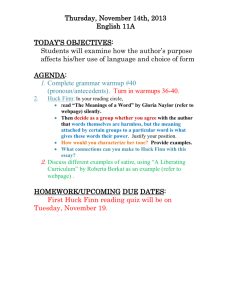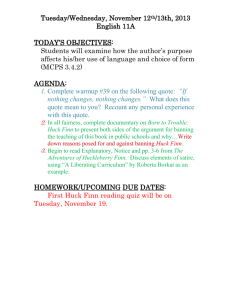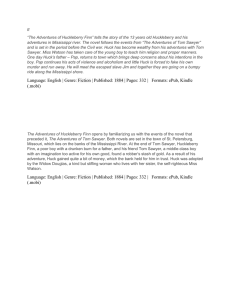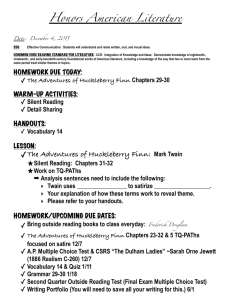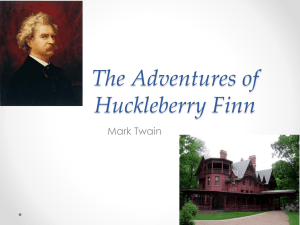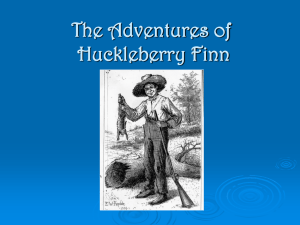Huckleberry Finn PowerPoint
advertisement
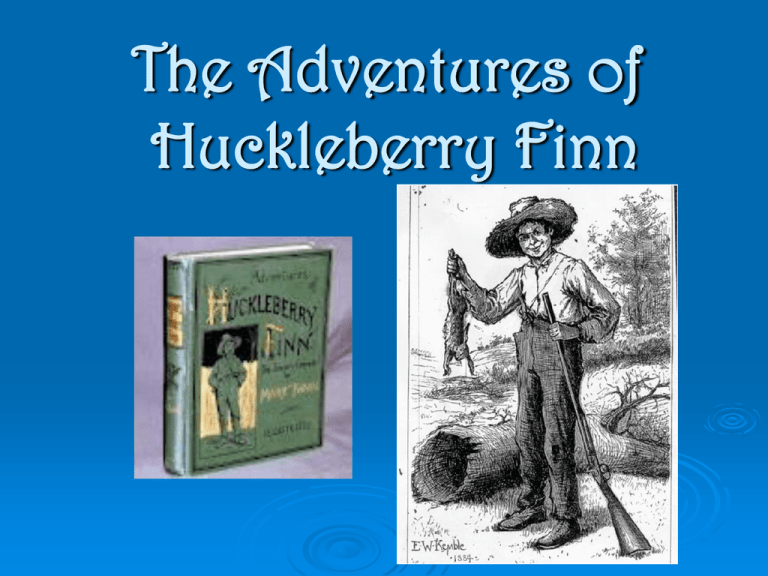
The Adventures of Huckleberry Finn by Mark Twain Samuel Langhorne Clemens Born November 30,1835, the night Halley’s Comet appeared (only appears every 75 years) Grew up along the Mississippi River Quit school at age 12 after father’s death, begins apprenticeship to a printer Apprentices on New Orleans riverboat in 1856 Becomes full-fledged riverboat pilot in 1859 Begins writing for newspapers in 1862 Publishes The Innocents Abroad in 1869 Marries Olivia Langdon in 1870 Publishes Tom Sawyer in 1876 and begins Huck Finn Completes Huck Finn in 1884 1890’s goes bankrupt due to several investments failing One daughter dies in 1896; wife dies in 1904 Dies on April 21, 1910, as Halley’s comet again flashed through the sky Twain’s Major Works Travel books (non-fiction) Innocents Abroad Life on the Mississippi Historic novels The Prince and the Pauper A Connecticut Yankee in King Arthur´s Court Short stories The Celebrated Jumping Frog of Calaveras Country Set along the Mississippi River during the 1830s or 1840s Few cities and towns; few schools in rural Missouri, Illinois, Arkansas, and Mississippi Most people lived off land Steam technology was becoming dominant No theaters, libraries, or museums in region Entertainment and popular education were offered by traveling showmen, musicians, circus performers, preachers, and lecturers Key Facts: Genre Satiric Novel (Fiction) • A work that uses humor, irony, and extreme exaggeration to ridicule society in order to bring about change Narrator & Protagonist Huck Finn: literal, realistic, practical, naive Setting • Before the Civil War; roughly 1835–1845 • The Mississippi River town of St. Petersburg, Missouri The Novel The Adventures of Huckleberry Finn was written after The Adventures of Tom Sawyer. At the end of Tom Sawyer, Huckleberry Finn, a poor boy with a drunken father, and his friend Tom Sawyer, a middleclass boy with an imagination too active for his own good, find a robber's stash of gold. As a result of his adventure, Huck gains quite a bit of money, which the bank holds for him in trust. Huck is taken in by the Widow Douglas, a kind but stifling woman who lives with her sister, the self-righteous Miss Watson. Mark Twain described the major theme of The Adventures of Huckleberry Finn as “A sound heart and a deformed conscience come into collision, and conscience suffers defeat.” Themes: What does Twain teach us about each idea? Racism & Slavery Intellectual and Moral Education The Hypocrisy of “Civilized” Society Racism & Slavery Although written 20 years after the Emancipation Proclamation, America – especially the South – was still struggling with racism and the aftereffects of slavery. Insidious racism arose near the end of Reconstruction that oppressed blacks for illogical and hypocritical reasons. Twain exposes the hypocrisy of slavery and demonstrates how racism distorts the oppressors as much as the oppressed. The result is a world of moral confusion. Intellectual and Moral Education Huck is an uneducated boy. He distrusts the morals and precepts of the society that treats him as an outcast and fails to protect him from abuse. Huck questions his teachings, especially regarding race and slavery. In many instances, Huck chooses to “go to hell” rather than go along with the rules of society.
